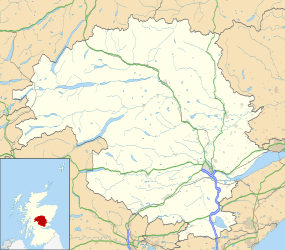RAF Balado Bridge
| RAF Balado Bridge | |||||||||||||||
|---|---|---|---|---|---|---|---|---|---|---|---|---|---|---|---|
| IATA: none – ICAO: X6BB[1] | |||||||||||||||
| Summary | |||||||||||||||
| Airport type | Military | ||||||||||||||
| Operator | Royal Air Force | ||||||||||||||
| Location | Kinross, Tayside, Scotland | ||||||||||||||
| Elevation AMSL | 424 ft / 130 m | ||||||||||||||
| Coordinates | 56°12′43″N 003°27′44″W / 56.21194°N 3.46222°W | ||||||||||||||
| Map | |||||||||||||||
 RAF Balado Bridge Location in Perth and Kinross | |||||||||||||||
| Runways | |||||||||||||||
| |||||||||||||||
RAF Balado Bridge, Tayside, Scotland is located 2 mi (3.2 km) west of Kinross,
It opened on 30 March 1942 as an Operational Training Unit & satellite airfield to RAF Grangemouth, it remained open until 1957. The airfield would have been named "RAF Kinross" however it was the custom not to name airfields with names that may be confused with somewhere else. In this case it may have been confused with RAF Kinloss, near Forres, which was the home to No. 19 OTU, a Bomber Command OTU flying Armstrong Whitworth Whitleys.
History
Second World War
No. 58 Operational Training Unit RAF (03/1942 - 06/1944) was primarily based at RAF Grangemouth, It used RAF Balado as a satellite, to ease the pressure on the airfield at Grangemouth.[2]
It had 2 Runways, both made of concrete. The tower was of the Watch Office for Fighter Satellite Station type(it was updated throughout its life).
There were two hangars, the larger of the two is a B1 type, designed by the engineers T Bedford as an aircraft repair shed, mainly for heavy bombers. This type first appeared in 1942 and were larger than the Bellman hangar which was also a temporary and transportable type. The smaller hangar was a Super Robin type.[3]
The Airfield was taken over by the War Department in November 1944.
Post War
After the war it became an aircraft graveyard when McDonnell Aircraft of nearby Milnathort broke up many hundreds of surplus Fleet Air Arm aircraft. The work reached its peak in 1946/7, but even as late as February 1952 their many airframes could still be seen in various stages of dismemberment. The most numerous were Harvards but there were also Fulmars, Fireflies, Martinets, Barracudas, Expeditors and a rare Fairchild Cornell FT673. Three Expeditors were all that remained in 1955.
It was also used from 1946 for light aircraft and gliding until its final closure in 1957.
Following decommissioning as an RAF station the site served as a ground station for the NATO satellite communications constellation.
Current use
The site is used by an Activity Centre & the Control Tower still stands to this day and was modernised into offices for the Activity Centre in 1997. [4][5]
There are also buildings for two Poultry Farms built on parts of the old runways.
From 1997 to 2014 it was used as the venue of the annual T in the Park music festival.
References
- ↑ Bones Aviation Page: A Catalogue of UK Airfields
- ↑ History of 58 OTU Website by Wallace Shackleton, Kinross
- ↑ Control Towers Website: RAF Balado Bridge
- ↑ Balado airfield
- ↑ Balado Park Website: Balado Park Home Page Archived 1 March 2009 at the Wayback Machine.